
The House of Leiningen is the name of an old German noble family whose lands lay principally in Alsace, Lorraine, Saarland, Rhineland, and the Palatinate. Various branches of this family developed over the centuries and ruled counties with Imperial immediacy.
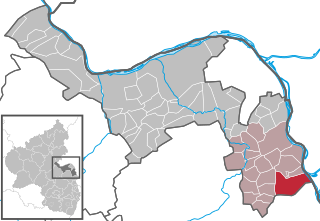
Guntersblum is an Ortsgemeinde– a municipality belonging to a Verbandsgemeinde, a kind of collective municipality – in the Frankfurt/Rhine-Main Metropolitan Region in the Mainz-Bingen district in Rhineland-Palatinate, Germany.
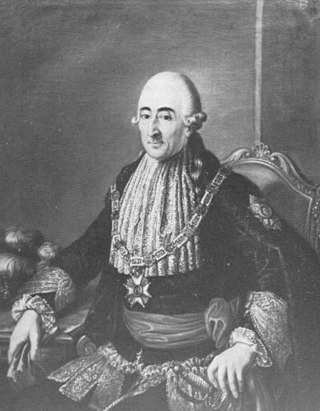
Carl Friedrich Wilhelm, Prince of Leiningen was a Prince of the Holy Roman Empire and the first ruler of the Principality of Leiningen.

The title of Prince of Leiningen was created by the Holy Roman Emperor Joseph II, who elevated Carl Friedrich Wilhelm, Count of Leiningen-Dagsburg-Hardenburg to the rank of Reichsfürst on 3 July 1779. Together with all other titles of nobility in Germany, it was abolished with the 1919 Weimar Constitution.

Karl, Prince of Leiningen, KG was the third Prince of Leiningen and maternal half-brother of Queen Victoria. Leiningen served as a Bavarian lieutenant general, before he briefly played an important role in German politics as the first Prime Minister of the Provisorische Zentralgewalt government formed by the Frankfurt Parliament in 1848.
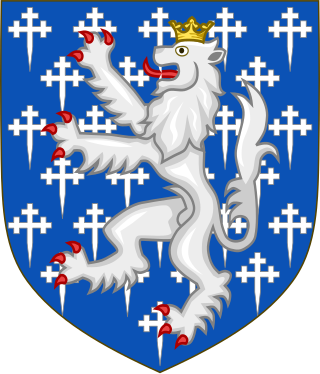
Simon III of Sarrebrück, Simon III von Saarbrücken (Saarbrücken-Leiningen) was the Count of Saarbrücken (de) from 1207 until his death, about 1240.

Neuleiningen Castle is a ruin on the eastern edge of the Palatinate Forest in the state of Rhineland-Palatinate in Germany in the municipality of Neuleiningen in the Bad Dürkheim district. It was built in 1238-41 by Count Frederick III of Leiningen. The French destroyed it in 1690 and it has lain in ruins since that time.

Count Christian Karl Reinhard of Leiningen-Dagsburg-Falkenburg was a German nobleman.

Caroline Felizitas of Leiningen-Dagsburg-Falkenburg was a German Imperial countess. By birth, she was member of the House of Leiningen and by marriage member of the House of Nassau.

The Principality of Leiningen was a short-lived principality ruled by the Prince of Leiningen.

Augusta Marie of Holstein-Gottorp (1649–1728) was a German noblewoman and by virtue of marriage Margravine of Baden-Durlach. Born into the House of Holstein-Gottorp, she was the daughter of Frederick III, Duke of Holstein-Gottorp and Duchess Marie Elisabeth of Saxony.

Christopher of Baden-Durlach was Prince and (titular) Margrave of Baden-Durlach.
Johann Karl August, Count of Leiningen-Dagsburg-Falkenburg was a German nobleman. By descent, he was Count of Leiningen and Dagsburg, by heritage, he was Lord of Broich and Bürgel.

Count John of Nassau-Idstein was Count of Nassau and Protestant Regent of Idstein.

Charles William was Prince of Nassau-Usingen from 1775 until his death. From 1797 until his death, he was also titular Prince of Nassau-Saarbrücken, however, Nassau-Saarbrücken was occupied by France during that period.
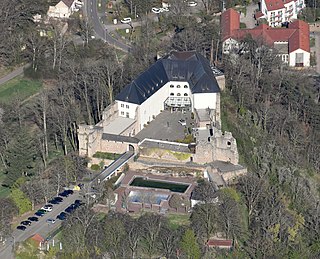
Altleiningen is a castle in the Palatinate Forest in Germany. It lies in the parish of Altleiningen in the county of Bad Dürkheim in the German state of Rhineland-Palatinate.
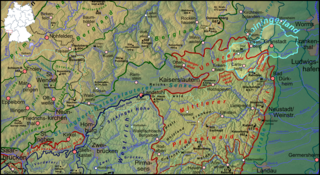
The Leiningerland is an historic landscape in the Palatinate region in the German federal state of Rhineland-Palatinate. It is named after an aristocratic family that used to be the most important in the region, the House of Leiningen.
Marie Christine Felizitas of Leiningen-Dagsburg-Falkenburg-Heidesheim, was a German noblewoman member of the House of Leiningen and by her two marriages Princess of Baden-Durlach and Duchess of Saxe-Eisenach.

The Barony of Westerburg, a small principality around the present day town of Westerburg in the Westerwald mountains of Germany, is first recorded in 1209. The eponymous castle, which had probably been built earlier than when it was mentioned for the first time in 1192, was the family seat of the lords of Westerburg, a branch of the lords of Runkel.

Schloss Dürkheim is a former Baroque-style palace in Bad Dürkheim, a spa town in Rhineland-Palatinate, Germany. It was the seat of the Counts and later Princes of Leiningen. Except for a few remnants, it has disappeared; today, the Kurhaus and the Kurpark-Hotel stand in its place.





































